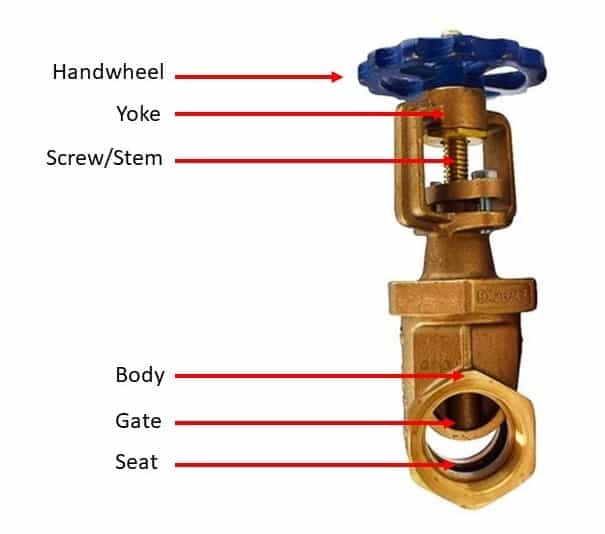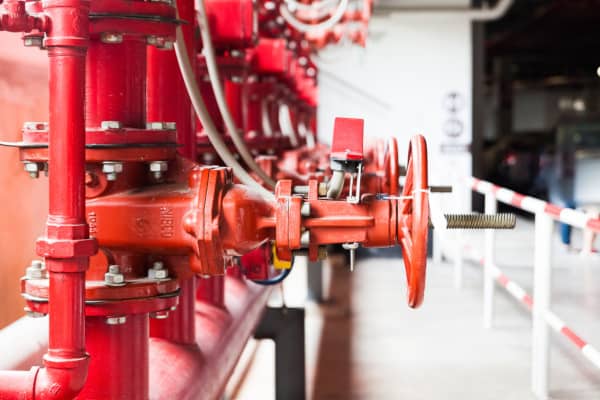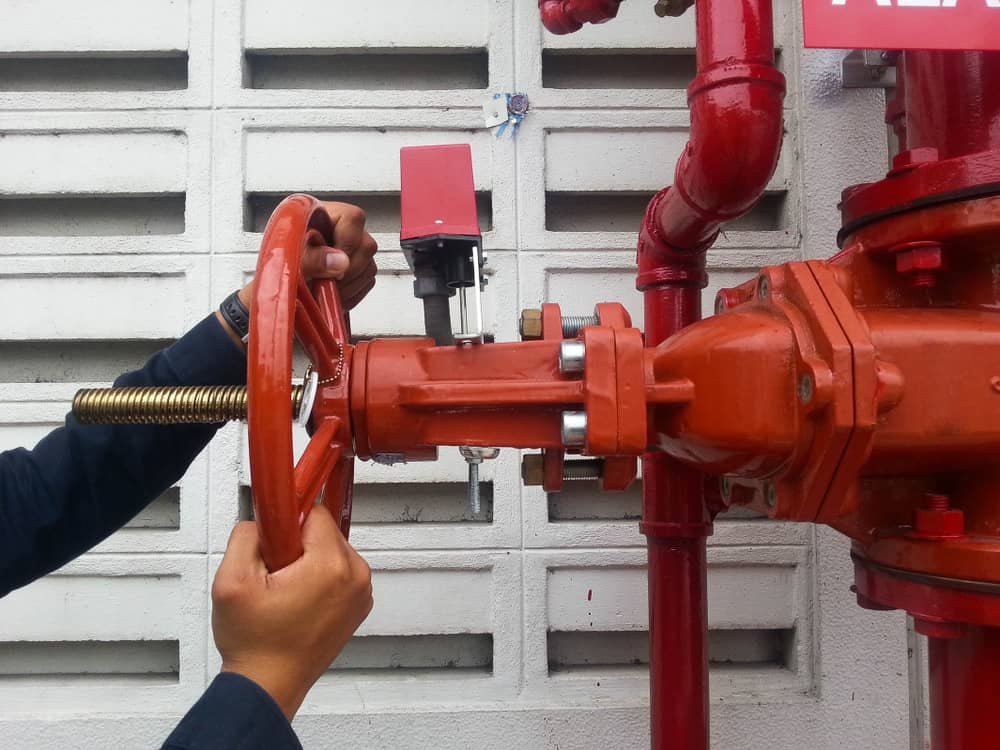An OS&Y valve often controls access to the water source in a fire sprinkler or standpipe system
Control valves are some of the most vital components of fire sprinkler and standpipe systems, controlling water flow to the network of pipes that feed the sprinklers. This article is a guide to outside screw and yoke (OS&Y) valves, which, along with butterfly valves, often serve as system control valves.
We cover:
- How OS&Y valves work and their basic construction
- Their applications, including why they are suitable control valves
- OS&Y valve benefits and why they might be used instead of butterfly valves
- The requirements for their inspection, testing, and maintenance
We’ll frequently refer to two model standards: NFPA 13: Standard for the Installation of Sprinkler Systems (2022 edition) and NFPA 25: Standard for the Inspection, Testing, and Maintenance of Water-Based Fire Protection Systems (2020 edition). Our focus here is on sprinkler systems, but much of the information we present (especially from NFPA 25) also applies to standpipes.
Whether you need a big order for a new construction project or just one replacement component, QRFS is your resource for fire protection supplies and equipment. Check out our selection of threaded OS&Y valves today!
How do OS&Y gate valves work?
OS&Y valves are gate valves, meaning that the flow of water is controlled by the movement of a barrier, or gate. The gate moves perpendicularly to the water’s path. When it is down and pressed against components in the valve body called the valve seats, a seal is formed, and water cannot flow. Pulling the gate up and away from the valve seat lets the water through.
OS&Y is an abbreviation for “outside screw and yoke” (also, sometimes “outside stem and yoke”), which explains the parts that make this happen. The gate is attached to a threaded screw/stem fitted into a handwheel. The handwheel is held in place by the yoke. Turning the handwheel moves the stem (and the gate) up and down.

OS&Y valves often serve as control valves
In fire protection, OS&Y valves are often used as control valves, which govern water flow to a fire sprinkler or standpipe system and possibly sections of it. If the main control valve is closed, the system is effectively “off,” rendering it useless. Every sprinkler system needs at least one main control valve—usually on the riser between the water main connection and the system’s network of pipes.
OS&Y valves make good control valves because they have two critical features required by NFPA 13: they are indicating, and they take at least five seconds to close. Here’s what the standard says:
From the 2022 edition of NFPA 13
16.9.3.1.2 At least one listed indicating valve shall be installed in each source of water supply.
3.3.235.3 * Indicating Valve.
A valve that has components that provide the valve operating position, open or closed. [24,2022] (AUT-PRI)
7.6.1 Valve Closure Time.
Listed indicating control valves shall not close in less than 5 seconds when operated at maximum possible speed from the fully open position.
To paraphrase the section: a control valve must be listed (approved for use by safety testing and approvals organizations like UL or FM Global) and indicating. Indicating valves do just what their names say: they visually indicate whether a valve is open or closed. It’s a vital feature because mistakenly closed control valves are the number one cause of fire sprinkler failure during an emergency.
Additionally, all sprinkler valves must close slowly—in at least 5 seconds—to avoid water hammer. Water hammer is a damaging surge in pressure that can happen when flowing water is stopped suddenly.
OS&Y valves meet these criteria perfectly. The valve clearly indicates its state: When the stem is up, it’s open. When the stem is down, the valve is closed. And the process of incrementally closing the valve—turning the handwheel multiple times—protects against pressure surges.
Benefits of OS&Y valves—lower-friction control of the water supply
As control valves, OS&Y valves are sometimes considered old-school. Contractors frequently prefer butterfly valves because they’re lightweight, reliable, and often prewired for electronic valve supervision that indicates whether they are open or closed. OS&Y valves can also be electronically supervised, but additional equipment is often required. Nevertheless, these old-school valves still have one benefit for sprinkler system designers: lower friction.
Building owners and facilities managers don’t usually think about the hydraulic design of their sprinkler systems or make choices about the valves they have—it’s just their job to maintain the equipment. But for sprinkler designers and contractors, valve selection can be important. Sprinkler design depends on achieving the required flow and pressure. And gravity plus friction from pipe walls, various fittings, and valves fight against these goals.
As gate valves, OS&Y valves reduce pressure and flow less than butterfly valves. That’s because the gate is entirely out of the path of the water when it’s open. In contrast, a butterfly valve’s disk remains somewhat in the water’s way even when it’s open. The latter creates more turbulence and friction, which can appreciably reduce pressure and flow.
NFPA 13’s Table 28.2.3.1.1 approximates the friction loss from fittings by comparing them to the friction loss experienced from equivalent lengths of pipe. Depending on their size, butterfly valves create between three and 10 times more friction loss than gate valves. Thus, if designers want to minimize water pressure and flow loss due to friction, they might specify using OS&Y control valves instead of butterfly control valves.
Inspection, testing, and maintenance of an OS&Y valve
Like all parts of a fire sprinkler or standpipe system, OS&Y gate valves must be inspected, tested, and maintained (ITM) regularly according to NFPA 25.
Fortunately, the list of tasks for these valves is short and simple. But before you try to do anything yourself, check your local ordinances—a licensed fire protection professional (and, at a minimum, always a “qualified” individual, as determined by the authority having jurisdiction) may be needed to do any ITM.
Inspection
All control valves require regular inspection. NFPA 25’s section 13.3.2.2 says you must check OS&Y control valves for:
- The proper signage marking them as control valves
- That they are sealed, locked, or supervised
- The correct position—open or closed
- Accessibility
- Any external leaks
The frequency of this inspection depends on how closely monitored control valves are. Valves without any lock, seal, or supervisory device must be inspected weekly. If they are locked or sealed open, this gets extended to a monthly interval. If, as NFPA 25 encourages, you have electronic supervision for your control valve, inspections can be carried out quarterly. Again, electronic supervision refers to devices that send a signal alerting whether a valve is closed.

Testing and maintenance
Like all control valves (13.3.3.1), an OS&Y control valve must be tested annually. The test is simple: operate the valve through its full range of motion, from fully opened to fully closed, back to the normal position. To prevent jamming, NFPA 25 says that the valve should be backed one quarter-turn from being fully opened (13.3.3.3). In addition to happening annually, this test should also be performed every time the valve has to be operated, such as during system repairs.
Maintenance on OS&Y valves is simple—the stem should be greased annually (13.3.4.1). The valve should be opened and closed to work the lubricant into threads, so the ideal time to lubricate an OS&Y valve is during the annual test.
NFPA 25 emphasizes that just opening the control valve after a test is not sufficient to verify the system is functional. Thus, it requires a valve status test (13.3.3.4) every time the valve has to be closed. Previously covered by a “main drain test,” this newer procedure also flows water to evaluate system pressure. Abnormally low pressures may indicate a leak or obstruction in the piping system.
OS&Y gate valves are a critical part of many fire sprinkler and standpipe systems
Every water-based fire protection system has control valves that must be maintained and remain open when the system is in service. And while many designers opt for butterfly valves due to their compact convenience, gate valves that open and close with an outside screw and yolk still have their place, often to satisfy hydraulic design requirements.
Like all approved control valves, OS&Y valves are indicating (the position of the stem shows whether the valve is open or closed), and they take time to close, preventing water hammer. As a building owner or contractor, you should typically replace the valve types currently in place if an inspection reveals it is required.
For your system repair jobs or new projects, shop our catalog of threaded OS&Y indicating valves. If you require a different model or otherwise need help placing an order, call 888-361-6662, email support@qrfs.com, or use our online contact form.
This blog was originally posted at blog.qrfs.com. Check us out at Facebook.com/QuickResponseFireSupply or on Twitter @QuickResponseFS.



Excellent explanation.
Thanks for this useful information. Some questions I had while reading this post.
What is the expected useful service life of an OS&Y valve that has had good and regular maintenance?
Is the expected useful service life different when the OS&Y valve is on the exterior of a building?
I have seen some OS&Y valves that don’t have a working viewing screen. Is this something that can be fixed or does it call for the entire OS&Y assembly to be replaced?
Jeyson — service life varies by manufacturer, with some specifying a decade. For more specific answers on that and viewing screen maintenance, you can try our Ask a Fire Pro service. Click the link to submit your question with some information about your building, and a fire protection professional will provide an answer based on best practices, standards, and codes. Our pros include AHJs, contractors, engineers, and code experts with 150+ years of combined experience!
Is there any guidance specifying the minimum distance around a Post Indicating Valve to allow for operation?
I do inspections on fire sprinkler systems for a living and in my experience OS&Y valves are the worst valves ever. I feel like I’m the only one that actually greases the stems of the valve. The article is telling you about no flow restriction and you can’t close it less then 5 seconds to prevent water hammering but what there not telling you is that rarely does anyone grease the stems to maintain the valve. One time it took me 2 minutes to close an OS&Y valve cause it was so stiff the valve was never greased. Also if you have that valve indoors they leak from the stem cause the packing gives out every few years big mess. My opinion is to use as less OS&Y valves as you can, butterfly valve are the better choice.
Ben — Thank you for your perspective; practical feedback from fire protection pros is almost always very valuable. OS&Ys have a few moderate system design advantages, hence their continued use (in new systems or existing systems) but valves require maintenance (as you point out). Some of your observations and others regarding convenience (such as integrated tamper switches) are why butterfly valves have become the more commonly preferred choice. Thanks for reading and commenting!